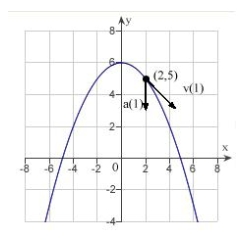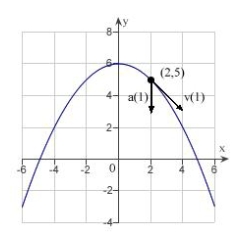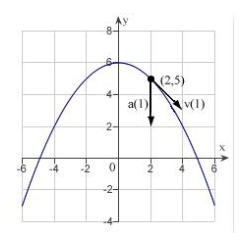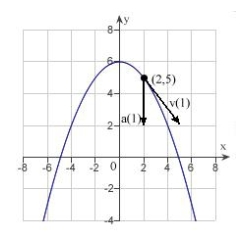Deck 12: Section 3: Vector-Valued Functions
Question
Question
Question
Question
Question
Question
Question
Question
Question
Question
Question
Question
Question
Question
Question
Question
Question
Question

Unlock Deck
Sign up to unlock the cards in this deck!
Unlock Deck
Unlock Deck
1/18
Play
Full screen (f)
Deck 12: Section 3: Vector-Valued Functions
1
The quarterback of a football team releases a pass at a height of 8 feet above the playing field, and the football is caught by a receiver 38 yards directly downfield at a height of 4 feet. The pass is released at an angle of  with the horizontal. Find the speed of the football when it is released. Round your answer to three decimal places.
with the horizontal. Find the speed of the football when it is released. Round your answer to three decimal places.
A) 33.169 feet per second
B) 59.366 feet per second
C) 19.462 feet per second
D) 118.732 feet per second
E) 190.165 feet per second
 with the horizontal. Find the speed of the football when it is released. Round your answer to three decimal places.
with the horizontal. Find the speed of the football when it is released. Round your answer to three decimal places.A) 33.169 feet per second
B) 59.366 feet per second
C) 19.462 feet per second
D) 118.732 feet per second
E) 190.165 feet per second
59.366 feet per second
2
A baseball, hit 9 feet above the ground, leaves the bat at an angle of  and is caught by an outfielder 9 feet above the ground and 500 feet from home plate. What is the initial speed of the ball? Round your answer to two decimal places.
and is caught by an outfielder 9 feet above the ground and 500 feet from home plate. What is the initial speed of the ball? Round your answer to two decimal places.
A) 31.62 ft/sec
B) 126.49 ft/sec
C) 189.74 ft/sec
D) 158.11 ft/sec
E) 63.25 ft/sec
 and is caught by an outfielder 9 feet above the ground and 500 feet from home plate. What is the initial speed of the ball? Round your answer to two decimal places.
and is caught by an outfielder 9 feet above the ground and 500 feet from home plate. What is the initial speed of the ball? Round your answer to two decimal places.A) 31.62 ft/sec
B) 126.49 ft/sec
C) 189.74 ft/sec
D) 158.11 ft/sec
E) 63.25 ft/sec
126.49 ft/sec
3
The position vector  describes the path of an object moving in space. Find the velocity
describes the path of an object moving in space. Find the velocity  of the object.
of the object.
A)
B)
C)
D)
E)
 describes the path of an object moving in space. Find the velocity
describes the path of an object moving in space. Find the velocity  of the object.
of the object.A)

B)

C)

D)

E)


4
A baseball, hit 5 feet above the ground, leaves the bat at an angle of  and its caught by an outfielder 5 feet above the ground and 500 feet from home plate. How high does the ball rise? Round your answer to the nearest integer.
and its caught by an outfielder 5 feet above the ground and 500 feet from home plate. How high does the ball rise? Round your answer to the nearest integer.
A) 77 feet
B) 10 feet
C) 167 feet
D) 118 feet
E) 23 feet
 and its caught by an outfielder 5 feet above the ground and 500 feet from home plate. How high does the ball rise? Round your answer to the nearest integer.
and its caught by an outfielder 5 feet above the ground and 500 feet from home plate. How high does the ball rise? Round your answer to the nearest integer.A) 77 feet
B) 10 feet
C) 167 feet
D) 118 feet
E) 23 feet

Unlock Deck
Unlock for access to all 18 flashcards in this deck.
Unlock Deck
k this deck
5
The position vector  describes the path of an object moving in space. Find the velocity
describes the path of an object moving in space. Find the velocity  of the object.
of the object.
A)
B)
C)
D)
E)
 describes the path of an object moving in space. Find the velocity
describes the path of an object moving in space. Find the velocity  of the object.
of the object.A)

B)

C)

D)

E)


Unlock Deck
Unlock for access to all 18 flashcards in this deck.
Unlock Deck
k this deck
6
The position vector  describes the path of an object moving in space. Find the speed
describes the path of an object moving in space. Find the speed  of the object.
of the object.
A) 21
B)
C)
D) 149
E)
 describes the path of an object moving in space. Find the speed
describes the path of an object moving in space. Find the speed  of the object.
of the object.A) 21
B)

C)

D) 149
E)


Unlock Deck
Unlock for access to all 18 flashcards in this deck.
Unlock Deck
k this deck
7
Use the given acceleration function and initial conditions to find the position at time t = 3. 
A)
B)
C)
D)
E)

A)

B)

C)

D)

E)


Unlock Deck
Unlock for access to all 18 flashcards in this deck.
Unlock Deck
k this deck
8
The position vector  describes the path of an object moving in the xy-plane. Sketch a graph of the path and sketch the velocity and acceleration vectors at the point
describes the path of an object moving in the xy-plane. Sketch a graph of the path and sketch the velocity and acceleration vectors at the point  .
.
A)
B)
C)
D)
E)
 describes the path of an object moving in the xy-plane. Sketch a graph of the path and sketch the velocity and acceleration vectors at the point
describes the path of an object moving in the xy-plane. Sketch a graph of the path and sketch the velocity and acceleration vectors at the point  .
.A)

B)

C)

D)

E)


Unlock Deck
Unlock for access to all 18 flashcards in this deck.
Unlock Deck
k this deck
9
Use the given acceleration function and initial conditions to find the position at time t = 1. 
A)
B)
C)
D)
E)

A)

B)

C)

D)

E)


Unlock Deck
Unlock for access to all 18 flashcards in this deck.
Unlock Deck
k this deck
10
A baseball player at second base throws a ball 87 feet to the player at first base. The ball is thrown 5 feet above the ground with an initial velocity of 50 miles per hour and at an angle of  above the horizontal. At which height does the player at first base catch the ball? Round your answer to three decimal places.
above the horizontal. At which height does the player at first base catch the ball? Round your answer to three decimal places.
A) 7.576 feet
B) 6.676 feet
C) 5.476 feet
D) 6.076 feet
E) 5.576 feet
 above the horizontal. At which height does the player at first base catch the ball? Round your answer to three decimal places.
above the horizontal. At which height does the player at first base catch the ball? Round your answer to three decimal places.A) 7.576 feet
B) 6.676 feet
C) 5.476 feet
D) 6.076 feet
E) 5.576 feet

Unlock Deck
Unlock for access to all 18 flashcards in this deck.
Unlock Deck
k this deck
11
The quarterback of a football team releases a pass at a height of 6 feet above the playing field, and the football is caught by a receiver 76 yards directly downfield at a height of 2 feet. The pass is released at an angle of  with the horizontal. Find the maximum height of the football. Round your answer to one decimal place.
with the horizontal. Find the maximum height of the football. Round your answer to one decimal place.
A) -377.3 feet
B) -374.2 feet
C) -425.8 feet
D) -528.2 feet
E) -583.0 feet
 with the horizontal. Find the maximum height of the football. Round your answer to one decimal place.
with the horizontal. Find the maximum height of the football. Round your answer to one decimal place.A) -377.3 feet
B) -374.2 feet
C) -425.8 feet
D) -528.2 feet
E) -583.0 feet

Unlock Deck
Unlock for access to all 18 flashcards in this deck.
Unlock Deck
k this deck
12
Use the given acceleration function and initial conditions to find the position at time t = 1. 
A)
B)
C)
D)
E)

A)

B)

C)

D)

E)


Unlock Deck
Unlock for access to all 18 flashcards in this deck.
Unlock Deck
k this deck
13
The position vector  describes the path of an object moving in space. Find the speed
describes the path of an object moving in space. Find the speed  of the object.
of the object.
A)
B)
C)
D)
E)
 describes the path of an object moving in space. Find the speed
describes the path of an object moving in space. Find the speed  of the object.
of the object.A)

B)

C)

D)

E)


Unlock Deck
Unlock for access to all 18 flashcards in this deck.
Unlock Deck
k this deck
14
Find the vector-valued function for the path of a projectile launched at a height of 20 feet above the ground with an initial velocity of 50 feet per second at an angle of 35 degrees above the horizontal. Use a graphing utility to graph the path of the projectile and confirm your selection. Let i be the unit vector in the horizontal direction and j the unit vector in the vertical direction.
A)
B)
C)
D)
E)
A)

B)

C)

D)

E)


Unlock Deck
Unlock for access to all 18 flashcards in this deck.
Unlock Deck
k this deck
15
Determine the maximum height of a projectile fired at a height of 6 feet above the ground with an initial velocity of 700 feet per second and at an angle of  above the horizontal. Use the model for projectile motion, assuming there is no air resistance. Round your answer to three decimal places.
above the horizontal. Use the model for projectile motion, assuming there is no air resistance. Round your answer to three decimal places.
A) 14,289.757 feet
B) 14,292.757 feet
C) 7,146.378 feet
D) 7,149.378 feet
E) 14,298.757 feet
 above the horizontal. Use the model for projectile motion, assuming there is no air resistance. Round your answer to three decimal places.
above the horizontal. Use the model for projectile motion, assuming there is no air resistance. Round your answer to three decimal places.A) 14,289.757 feet
B) 14,292.757 feet
C) 7,146.378 feet
D) 7,149.378 feet
E) 14,298.757 feet

Unlock Deck
Unlock for access to all 18 flashcards in this deck.
Unlock Deck
k this deck
16
The quarterback of a football team releases a pass at a height of 8 feet above the playing field, and the football is caught by a receiver 46 yards directly downfield at a height of 4 feet. The pass is released at an angle of  with the horizontal. Find the time in seconds the receiver has to reach the proper position after the quarterback releases the football. Round your answer to one decimal place.
with the horizontal. Find the time in seconds the receiver has to reach the proper position after the quarterback releases the football. Round your answer to one decimal place.
A) 7.0 seconds
B) 2.3 seconds
C) 4.1 seconds
D) 0.7 second
E) 1.1 seconds
 with the horizontal. Find the time in seconds the receiver has to reach the proper position after the quarterback releases the football. Round your answer to one decimal place.
with the horizontal. Find the time in seconds the receiver has to reach the proper position after the quarterback releases the football. Round your answer to one decimal place.A) 7.0 seconds
B) 2.3 seconds
C) 4.1 seconds
D) 0.7 second
E) 1.1 seconds

Unlock Deck
Unlock for access to all 18 flashcards in this deck.
Unlock Deck
k this deck
17
The position vector  describes the path of an object moving in space. Find the acceleration
describes the path of an object moving in space. Find the acceleration  of the object.
of the object.
A)
B)
C)
D)
E)
 describes the path of an object moving in space. Find the acceleration
describes the path of an object moving in space. Find the acceleration  of the object.
of the object.A)

B)

C)

D)

E)


Unlock Deck
Unlock for access to all 18 flashcards in this deck.
Unlock Deck
k this deck
18
Determine the range of a projectile fired at a height of 5 feet above the ground with an initial velocity of 1000 feet per second and at an angle of  above the horizontal. Use the model for projectile motion, assuming there is no air resistance. Round your answer to three decimal places.
above the horizontal. Use the model for projectile motion, assuming there is no air resistance. Round your answer to three decimal places.
A) 15,627.500 feet
B) 8,137.843 feet
C) 31,252.187 feet
D) 31,254.999 feet
E) 16,268.138 feet
 above the horizontal. Use the model for projectile motion, assuming there is no air resistance. Round your answer to three decimal places.
above the horizontal. Use the model for projectile motion, assuming there is no air resistance. Round your answer to three decimal places.A) 15,627.500 feet
B) 8,137.843 feet
C) 31,252.187 feet
D) 31,254.999 feet
E) 16,268.138 feet

Unlock Deck
Unlock for access to all 18 flashcards in this deck.
Unlock Deck
k this deck



